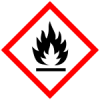Coalition status
FSC restricted HHPs
Chemical pesticide presenting one out of three of the following hazards: acute toxicity, chronic toxicity and environmental toxicity.
Details
Type: Pesticide
Use: Molluscicide
Example applications: Ornamentals;Fruit trees and bushes;Various other fruits including avocado, citrus and berries;Vegetables including broccoli, cauliflower, cabbage and articokes
Example pests controlled: Slugs;Snails
Mode of action: Contact and stomach action
Source: PPDB
Toxicty
Bird toxicity
Highly toxic to birds acute oral LD50 (LD50 < 200mg/bg bw)
Highly toxic to birds acute oral LD50 (LD50 < 200mg/bg bw)
GHS safety labels
About Globally Harmonized System of Classification and Labelling of Chemicals (GHS)
From Wikipedia: The Globally Harmonized System of Classification and Labelling of Chemicals (GHS) is an internationally agreed-upon standard managed by the United Nations that was set up to replace the assortment of hazardous material classification and labelling schemes previously used around the world. Core elements of the GHS include standardized hazard testing criteria, universal warning pictograms, and harmonized safety data sheets which provide users of dangerous goods with a host of information. The system acts as a complement to the UN Numbered system of regulated hazardous material transport. Implementation is managed through the UN Secretariat. Although adoption has taken time, as of 2017, the system has been enacted to significant extents in most major countries of the world.[1] This includes the European Union, which has implemented the United Nations' GHS into EU law as the CLP Regulation, and United States Occupational Safety and Health Administration standards.
- H228

Flammable solid
Class: Flammable
Subclass: Solids - H301

Toxic if swallowed
Class: Acute Toxicity
Subclass: Oral - H361

Suspected of damaging fertility or the unborn child (state specific effect if known)(state route of exposure if it is conclusively proven that no other routes of exposure cause the hazard)
Class: Toxic to Reproduction - H412
Harmful to aquatic life with long lasting effects
Class: Aquatic
Subclass: Chronic
